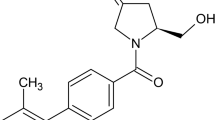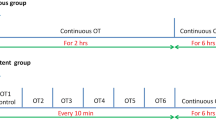Abstract
Objective
To ascertain the relative activity of five oxytocin antagonists (OTAs) in vivo in a tethered pregnant baboon model and compare these results to previously reported affinities in human and rat oxytocin receptor assays and median effective dose in rat uterotonic bioassay.
Methods
Pregnant tethered baboons between days 130 and 160 of pregnancy were given an oxytocin challenge test 1 minute after infusion of 1 mg of one of five randomly selected OTAs: ANTAG I, ANTAG II, ANTAG III, L366948, and Atosiban. Once the uterine response to exytocin returned to normal (1-8 days) the OCT was repeated with one of the remaining, untested OTAs during the 130-160 day period. Uterine activity, the time until the first significant response, and the dose of oxytocin needed to induce this response were all factored into one expression, the antagonist-response interval (ARI).
Results
When expressed as ratio to ANTAG I the relative ARI for the OTAs were 0, .5, 1.0, 2.4 and 59.2 for L366948, Atosiban, ANTAG I, ANTAG II, and ANTAG III, respectively. ANTAG III and L366948 were significantly different from each other and the three other OTAs (P < .05). The log10 ARI for the 4 active OTAs when correlated with the log10 of the human and rat oxytocin receptor affinities and the rat uterotonic bioassay were all highly correlated (r = .99; P < .05).
Conclusion
ANTAG III is a potent, long-acting OTA in vivo in the pregnant baboon and has the potential as a tocolytic in humans.
Similar content being viewed by others
References
The Canadian Preterm Labor Investigation Group. Treatment of preterm labor with the beta-adrenergic agonist ritodrine. N Engl J Med 1992; 327: 308–12.
Higby K, Xenaxis EM, Pauerstein CJ. Do tocolytic agents stop preterm labor? A critical and comprehensive review of efficacy and safety. Am J Obstet Gynecol 1993; 168: 1247–59.
Wilson L Jr, Parsons MT, Ouano L, Flouret G. A new tocolytic agent: Development of an oxytocin antagonist for inhibiting uterine contractions. Am J Obstet Gynecol 1990; 163: 195–202.
Wilson L Jr, Parsons MT, Flouret G. Inhibition of spontaneous uterine contractions during the last trimester in the pregnant baboon by an oxytocin antagonist. Am J Obstet Gynecol 1990; 163: 1875–82.
Fejgm MD, Pak SC, Warnell C, Flouret G, Wilson L Jr. Oxytocin antagonist inhibitory effect in the baboon and rat uterus may be overcome by the use of prostaglandins. Am J Obstet Gynecol 1994; 171: 1076–80.
Flouret G, Brieher W, Mahan K, Wilson L Jr. Design of potent oxytocin antagonist featuring D-tryptophan at position 2. J Med Them 1991; 34: 642–6.
Flouret G, Majewski T, Brieher W, et al. Potent antagonists of oxytocin uterotonic action substituted with analogues of 3, 3-pentamethylene-3-mercaptopropionic acid. In: HLS Maia, ed. Peptides 1994. Leiden: ESCOM, 1995: 341–2.
Pak SC, Bertoncim D, Meyer W, Scaunas D, Flouret G, Wilson L Jr. Comparison of binding affnity of oxytocin antagonists to human and rat uterine oxytocin receptors and their correlation to the rat uterine oxytocic bioassay. Biol Reprod 1994; 51: 1140–4.
Wilson L Jr, Parsons MT, Flouret G. Forward shift in the initiation of nocturnal estradiol surge in the pregnant baboon: Is this the genesis of labor? Am J Obstet Gynecol 1991; 165: 1487–98.
Demarest KT, Hahn DW, Ericson E, Capetola RJ, Fuchs AR. Profile of an oxytocin antagonist, RWJ 22164 for treatment of preterm labor in laboratory models of uterine contractility. Am J Pennat 1989; 6: 200–4.
Hahn DW, Demarest KT, Encson E, Homm RE, Capetola RJ, McGuire JL. Evaluation of l-deamino-[D-Tyr(Oethyl)2, Thr4 Orn ] vasotocin, an oxytocin antagonist, in animal models of uterine contractiliry and preterm labor: A new tocolytic agent. Am J Obstet Gynecol 1987; 157: 977–82.
Pettibone DJ, Clineschmidt BV, Anderson PS, et al. A structurally unique, potent and selective oxytocin antagonist derived from Streptomyces sih’ensis. Endocrinology 1989; 125: 217–22.
Chneschmidt BV, Pettibone DJ, Reiss DR, et al. Antagonism of oxytocin in rats and pregnant rhesus monkeys by the novel cyclic hexapeptides, L–366,682 and L–366,948. J Pharmacol Exp Therapeutic 1990; 256: 827–32.
Norusis, MJ, ed. Scientific Package for Social Sciences/PC for Windows 6.1. Chicago: SPSS Inc., 1994.
Creasy RK. Preterm birth prevention: Where are we? Am J Obstet Gynecol 1993; 168: 1223–30.
Fuchs F, Niebel J. Principles of tocolysis: An overvew. In: Fuchs AR, Fuchs F, Stubblefield, PG, eds. Preterm birth. New York: McGraw-Hill, 1993: 217.
Andersen LF, Lyndrup J, Akerlund M, Melin P. Oxytocin receptor blockade: A new principle in the treatment of preterm labor? Am J Pennat 1989; 6: 196–9.
Goodwin TM, Paul RH, Silver H, et al. The effect of the oxytocin antagonist Atosiban on preterm labor uterine activity in the human. Am J Obstet Gynecol 1994; 170: 474–8.
Author information
Authors and Affiliations
Additional information
Supported in part by National Institutes of Health grant HD-22567 to G. F, and HD-25888 to L. W.
Rights and permissions
About this article
Cite this article
Fejgin, M.D., Pak, S.C., Flouret, G. et al. Comparison of the In Vivo Activity of Different Oxytocin Antagonists in the Pregnant Baboon. Reprod. Sci. 5, 251–254 (1998). https://doi.org/10.1177/107155769800500505
Published:
Issue Date:
DOI: https://doi.org/10.1177/107155769800500505




